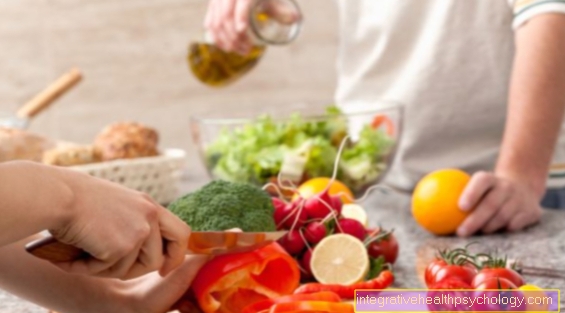Meal and food planning for overweight children and adolescents
Meals

Regular meals are important in order to keep the blood sugar level constant and to avoid performance dips and cravings.
Five meals are recommended and this is usually one warm
meal, two cold meals and 2 small snacks in between.
the main meal
The warm meal is usually taken at noon. However, there is nothing to be said against consuming this warm meal in the evening, in line with family habits. The main meal is based on potatoes, rice or noodles, plus plenty of vegetables or a salad made from raw vegetables.
There is meat 2-3 times a week and this portion is rather small compared to the vegetables and side dishes. Low-fat meats should be selected.
Some hot meals during the week are meatless and based on cereals, legumes or potatoes. Once a week is intended to provide high-quality protein and iodine Sea fish are on the menu.
Two cold meals a day
The cold meals are usually breakfast and dinner. They consist primarily of low-fat milk and milk products, bread or cereal flakes as well as fruit or raw vegetables. Examples are a sandwich with raw vegetables and a glass of milk or a muesli with yogurt and fresh fruit.
Two snacks a day
These are the sandwiches and a small afternoon meal. These consist of bread or cereal flakes with raw vegetables or fresh fruit. Milk and milk products can also be added. From time to time it can also be small portions of sweets or cakes (afternoon meal).
Every meal should have a low-energy or energy-free drink such as mineral water or unsweetened fruit or herbal tea.
Danger: Milk is a nutrient-rich food and is not a drink!
Food selection with the optimized mixed diet
1. Drinks
Water is the main component of the human body. Our body has no water reservoir and is dependent on regular supply from outside. Humans can get by for up to 40 days without solid food and only survive 4 days without water. The vital organs then fail. We are dependent on taking fluids throughout the day. If you feel thirsty, it is actually already too late and symptoms such as headache, tiredness, difficulty concentrating, dry eyes, etc. already exist. Depending on their age, children should drink between 600 ml and 1.5 l of fluid daily. The need for water increases significantly in extreme heat, sporting activity and sweating.
The ideal drink is water. Drinking water from the tap (analyzes are available from the local waterworks) or as mineral water. Mineral water contains minerals and trace elements in dissolved form and can therefore be easily absorbed by the body. The calcium content is important in children and regulates the growth of bones and the resilience of the teeth.
Unsweetened herbal and fruit teas are also recommended.
For fruit juices, only the natural varieties are suitable (100% juice and no added sugar). These fruit juices are best diluted to quench your thirst (1 part fruit juice and two parts water) or can also be drunk neat as a vitamin-rich supplement to breakfast or another meal. They are then to be assessed as a fruit portion.
Fruit nectars and fruit juice drinks are fruit juices that are diluted with water and contain added sugar. Lemonades have an even lower fruit juice content. Cola, malt beer and iced tea also contain large amounts of sugar, which means high energy levels and are by no means suitable for quenching thirst.
Caffeinated drinks such as coffee or black tea are also unsuitable, but are possible in limited quantities for young people.
Drinking properly means:
Offer something to drink with every meal
Always have drinks ready between meals.
Choose drinks that are as free of energy as possible, preferably water.
2. Bread, cereals, breakfast cereals
These foods have a particularly high priority in child nutrition. At least half of all grain products should Whole grain products be. There are particularly many in the outer layers and in the seedling of the grain Vitamins (B vitamins) and minerals (Magnesium, iron), Dietary fiber, Proteins and important essential fatty acids, whole grain products are very valuable and make an important contribution to the healthy nutrition of our children and young people.
Ground flour (Type 405) and products made from it contain far fewer important nutrients than whole wheat flour. The degree of grinding is synonymous with the type designation and the higher the type number of the flour (for example Type 1050) the more important nutrients it contains. Whole wheat flour is complete (contains all outer layers and the seedling) and has no type of information.
Whole grain bread can contain whole grains, but can also be baked from finely ground grain. Whole wheat flour can also be mixed with the ground flour (for example with pancake batter or pizza batter) and this makes it easier to get used to the new taste.
The so-called multigrain bread is in most cases bread made from ready-made baking mixes with a high proportion of ground flours.
Breakfast cereals (breakfast cereals), for example, cornflakes are mostly highly processed products and the impression is given that these products are particularly healthy and part of an optimal diet. Unfortunately, these breakfast cereals no longer have much to do with the original cereal but contain little fiber and even more sugar. Vitamins are usually added. These foods are more like candy.
Whole grain cereal flakes are ideal for breakfast (Oat flakes, wheat flakes, wheat germ) with milk or yoghurt and fresh fruit. Ready-made muesli mixes are also possible, but they should not contain any added sugar. Muesli can be sweetened better with a little liquid honey.
Attention! Sugar often appears in the list of ingredients under other names such as sucrose, glucose syrup or glucose, fructose, maltodextrin).
Children should never leave the house without breakfast and if they don't want to eat anything they should at least drink a cup of milk or cocoa and take a healthy snack with them.
3. Potatoes, pasta and rice
In a healthy diet, side dishes are not side dishes, but the main components of a warm meal. They consist primarily of carbohydrates in the form of starch. Potatoes are very nutritious and contain vegetable protein, potassium and vitamin C. Freshly cooked, low-fat potatoes are the ideal accompaniment. It is best to cook them in the bowl, so that they contain important nutrients that would otherwise be thrown away with the cooking water (such as the water-soluble vitamin C.).
Rice and pasta are of course the most valuable in the wholemeal variety. To get children used to the taste, they can also be mixed with the conventional variant.
4. Vegetables and fruits

They are the main suppliers for Vitamins and Minerals, have a high nutrient density but a low energy density. In addition to vitamins and minerals, these foods also contain so-called "secondary plant substances".
These chemical compounds are only found in natural fruits and vegetables - not in food supplements such as vitamin tablets and similar products. These very different substances (Polyphenols, carotenoids, phytosterols, phytoestrogens) are also called bioactive substances and they are said to have various health-promoting properties. They have a positive effect on the immune system and are said to reduce the risk of cancer.
A healthy diet should include 5 servings of fruits and vegetables per day. The hand measure applies here for determining the portion. In practice this could mean for a 10 year old child: a small apple, 1 small banana, 2 small tomatoes, a small zucchino and a small kohlrabi daily. The mentioned types of fruit and vegetables are of course interchangeable depending on your taste.
Also a glass of natural fruit juice (without Added sugar) is best freshly squeezed or a glass of vegetable juice can count as a fruit or vegetable portion.
When choosing fruits and vegetables, seasonal availability should also be considered. Strawberries in January are mostly polluted and also leave a lot to be desired in terms of taste.
Fruit as fresh as possible and vegetables as raw vegetables are ideal. It doesn't always have to be a salad, but carrot sticks, cucumber slices, and radishes can be eaten with bread or as a snack.
Fruit and vegetables lose their nutrients during storage and preparation. Therefore always pay attention to freshness or use frozen products. Their nutritional content largely corresponds to that of fresh products because they are frozen quickly after harvest.
Canned vegetables and fruits are not recommended. Your usage should be the exception. Canned fruit usually contain a lot of sugar.
At vegetables Pay attention to low-fat preparation. It is best to cook in a little water until firm to the bite and only add a little high-quality vegetable oil and fresh herbs after the cooking process. In no case cook vegetables too long and mushy. It loses nutrients and taste.
legumes such as lentils, peas and beans are very nutritious and contain valuable protein, many minerals, vitamins and fiber. Legumes should be on the menu once a week, for example as a lentil or pea stew with vegetables.
Children who do not like fruit and vegetables have to be introduced slowly in small steps and with a lot of patience. Often a fruit salad is eaten rather than a piece of fruit from the fruit basket. Most children like pureed fruit or a milkshake with fresh fruit.Yoghurt or quark dishes with fresh fruit can also be offered, and a sorbet made from pureed fruit in summer or as a dessert.
fruit Also tastes delicious as a topping on bread. For example, whole grain bread with low-fat cream cheese and banana or apple slices.
vegetables can be "hidden" in sauces in small, grated form. For example, grated carrots in tomato sauce or soup. Onions make sauces, when they are soft-boiled, creamy and you no longer need a binding.
Vegetable pieces as raw vegetables with dip or with bread, lettuce leaves and cucumber slices on rolls or bread. Radishes and tomatoes as a topping on bread. Children often prefer to eat vegetables as raw vegetables rather than cooked.
In order to achieve the 5 servings of fruit and vegetables daily, a glass of natural fruit or vegetable juice can also be counted as a serving.

























.jpg)



